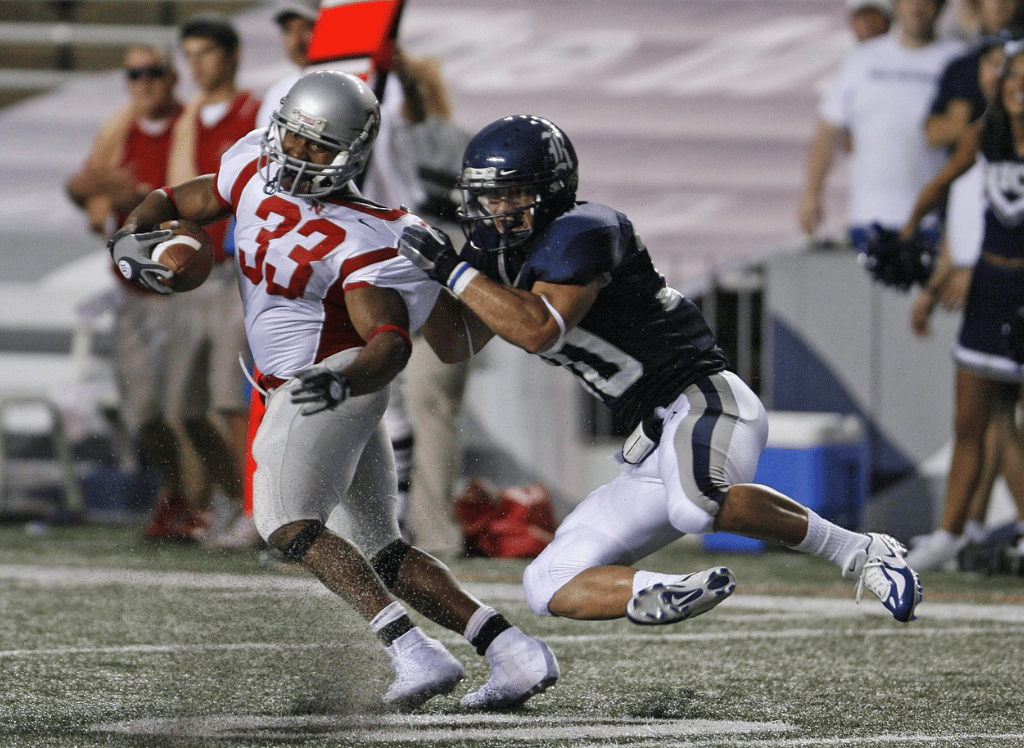Fantasy football is like a game of chess, but with NFL players as your pieces. One of the most popular formats in this strategic game is PPR, or Points Per Reception.
What is PPR in fantasy football?
PPR (Points Per Reception) is a scoring system used in fantasy football that rewards players for catching the ball. In traditional fantasy football leagues, players earn points based on their receiving yards gained.
This means that wide receivers, running backs, and tight ends who catch more passes have an advantage over those who primarily gain yards through rushing or receiving touchdowns. Each reception can earn you 0.5 points, 1.0 point, or whatever your league settings are set to be.
The Basics of PPR Scoring
Unlike standard scoring formats, where points are primarily awarded for yards and touchdowns, PPR adds an extra layer of excitement by giving points for each catch. This means that players who rack up receptions, like wide receivers and pass-catching running backs, become more valuable.
In a PPR scoring system, each reception typically earns one point. So if your wide receiver catches ten passes in a game, that's an additional ten points on top of their receiving yards and touchdowns. This scoring format can drastically change the value of individual players and make your draft day decisions even more critical.
1-Point PPR vs. Half-Point PPR
While full PPR leagues award one point per reception, half-point PPR leagues give half a point for each catch. This scoring format strikes a balance between standard and full PPR, rewarding receptions without making them overly dominant.
In half-point PPR leagues, players who catch a lot of passes still have added value, but the gap between them and traditional yardage and touchdown scorers is smaller. This can make for a more balanced and competitive league, where different draft strategies can be successful.
Why PPR is a Popular Format
PPR has gained popularity because it adds a new dimension to fantasy football. It rewards players who are heavily involved in their team's offense, even if they don't score touchdowns.
For example, in a standard scoring league, a running back who rushes for 100 yards and scores a touchdown might be the star of the week. But in a PPR league, a running back who catches eight passes for 50 yards could outscore the traditional workhorse. This shift in value makes PPR leagues more dynamic and exciting.
The Importance of Draft Day in PPR Leagues
Draft day is the most critical day of the fantasy football season.
For example, targeting wide receivers and pass-catching running backs early in the draft can set your team up for success. Players who are heavily involved in their team's passing game can provide a steady stream of points throughout the season.
Draft Strategy in PPR Leagues
Drafting in a PPR league requires a different approach than in standard scoring formats. Since receptions are so valuable, players who catch a lot of passes should be high on your draft board. The high volume catching wide receivers and pass-catching running backs become premium picks, while traditional power runners might slide down the rankings.
For instance, a player like Christian McCaffrey, known for his dual-threat ability, becomes a top pick in PPR leagues. His ability to rack up both rushing yards and receptions makes him a fantasy goldmine. On the other hand, a running back like Derrick Henry, who primarily gains yards on the ground but doesn't catch as many passes might not be as valuable.
The Impact of PPR on Weekly Lineups
Setting your starting lineup in a PPR league can be a bit like solving a Rubik's Cube. You need to consider not just the matchups but also the players' involvement in the passing game. A wide receiver who catches a lot of short passes might be more valuable than a deep threat who only catches a few long balls.
For example, a player like Keenan Allen, known for his high reception totals, can be a weekly starter in PPR leagues even if he doesn't score many touchdowns. His consistent reception points provide a solid floor, making him a reliable option in your lineup.
The Value of Pass-Catching Running Backs
Pass-catching running backs are heroes of PPR leagues. Players like Alvin Kamara and Breece Hall, who excel in both rushing and receiving, become top picks. Their ability to contribute in multiple ways makes them invaluable assets.
In a standard scoring league, a running back who catches a lot of passes might not be as valuable as a pure rusher. But in PPR leagues, their reception points can make up for any lack of rushing yards, making them consistent point producers.
Wide Receivers in PPR Leagues
Wide receivers are the bread and butter of PPR leagues. Players who consistently catch a high volume of passes, like CeeDee Lamb and Tyreek Hill, become cornerstone pieces of your fantasy team. Their reception points provide a reliable floor, while their yardage and touchdowns offer upside.
In PPR leagues, it's essential to target wide receivers who are heavily involved in their team's offense. Players who see a high number of targets each week are more likely to rack up receptions and provide consistent fantasy points.
Tight Ends in PPR Leagues
Tight ends can be a tricky position to navigate in fantasy football, but PPR scoring can make them more valuable. Players like Evan Engram and Travis Kelce, who are heavily involved in their team's passing game, become top-tier options in PPR leagues.
In a standard scoring format, tight ends who don't score touchdowns might not be worth starting. But in PPR leagues, their reception points can make them valuable contributors. This means you can find hidden gems at the tight end position who can give your team a significant boost.
The Importance of Reception Points
Reception points reward players for their involvement in the passing game, making every catch count. This scoring format encourages a more strategic approach to drafting and lineup decisions.
In PPR leagues, it's crucial to target players who are heavily involved in their team's passing game. Whether it's a wide receiver, running back, or tight end, players who consistently catch passes can provide a steady stream of points.
Receiving Yards
While receptions are the primary focus in PPR leagues, receiving yards still play a significant role. Players who can rack up both receptions and yards become even more valuable, as they contribute in multiple ways.
Touchdowns in PPR Leagues
Touchdowns are the cherry on top in PPR leagues. While receptions and yards provide a solid foundation, touchdowns can give your team a significant boost. Players who can find the end zone regularly become even more valuable.
In PPR leagues, it's still essential to target players who have a nose for the end zone. Whether it's a wide receiver, running back, or tight end, players who can score touchdowns can provide a significant advantage.
PPR League FAQs
What is PPR in fantasy football?
PPR stands for Points Per Reception. In PPR leagues, players earn points for each reception, making pass-catching players more valuable.
How does PPR scoring impact draft strategy?
In PPR leagues, it's essential to target players who catch a lot of passes. Wide receivers and pass-catching running backs become premium picks, while traditional power runners might slide down the rankings.
Why are pass-catching running backs valuable in PPR leagues?
Pass-catching running backs are valuable in PPR leagues because they can contribute in both the rushing and passing game. Their reception points can make up for any lack of rushing yards, making them consistent point producers.
What is the difference between standard and PPR in fantasy football?
The main difference between standard and PPR scoring in fantasy football is how points are awarded for receptions.
What is PPR vs non-PPR?
PPR stands for Points Per Reception, while non-PPR refers to standard scoring leagues where players do not receive any points for their receptions.
Is PPR or half PPR better?
The answer is subjective and depends on personal preference. Some fantasy players prefer PPR leagues because it rewards pass-catching players more, while others prefer half PPR (where receptions are worth 0.5 points) as it provides a balance between standard and PPR scoring.
What does 0.5 PPR mean?
0.5 PPR stands for 0.5 Points Per Reception. In this scoring format, players receive half a point for each reception they make.
What position is most valuable in PPR fantasy football?
In PPR fantasy football leagues, wide receivers and pass-catching running backs tend to be the most valuable positions. These players have a higher likelihood of catching passes and earning points for receptions, making them more consistent point producers compared to traditional power runners.
Summary
PPR leagues add a new dimension to fantasy football by rewarding players for their receptions. This scoring format makes wide receivers and pass-catching running backs more valuable, adding a new layer of strategy to draft day and weekly lineup decisions. Understanding PPR scoring can help you build a winning fantasy team and dominate your league.
Please browse through our other fantasy football smacks:









